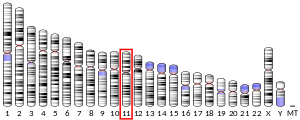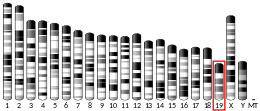FLRT1
Fibronectin leucine rich transmembrane protein 1 is a protein that in humans is encoded by the FLRT1 gene. [5]
Function
This gene encodes a member of the fibronectin leucine rich transmembrane protein (FLRT) family. The family members may function in cell adhesion and/or receptor signalling. Their protein structures resemble small leucine-rich proteoglycans found in the extracellular matrix. The encoded protein shares sequence similarity with two other family members, FLRT2 and FLRT3. This gene is expressed in the kidney and brain.
References
- GRCh38: Ensembl release 89: ENSG00000126500 - Ensembl, May 2017
- GRCm38: Ensembl release 89: ENSMUSG00000047787 - Ensembl, May 2017
- "Human PubMed Reference:". National Center for Biotechnology Information, U.S. National Library of Medicine.
- "Mouse PubMed Reference:". National Center for Biotechnology Information, U.S. National Library of Medicine.
- "Entrez Gene: Fibronectin leucine rich transmembrane protein 1". Retrieved 2017-05-30.
Further reading
This article incorporates text from the United States National Library of Medicine, which is in the public domain.
This article is issued from Wikipedia. The text is licensed under Creative Commons - Attribution - Sharealike. Additional terms may apply for the media files.



